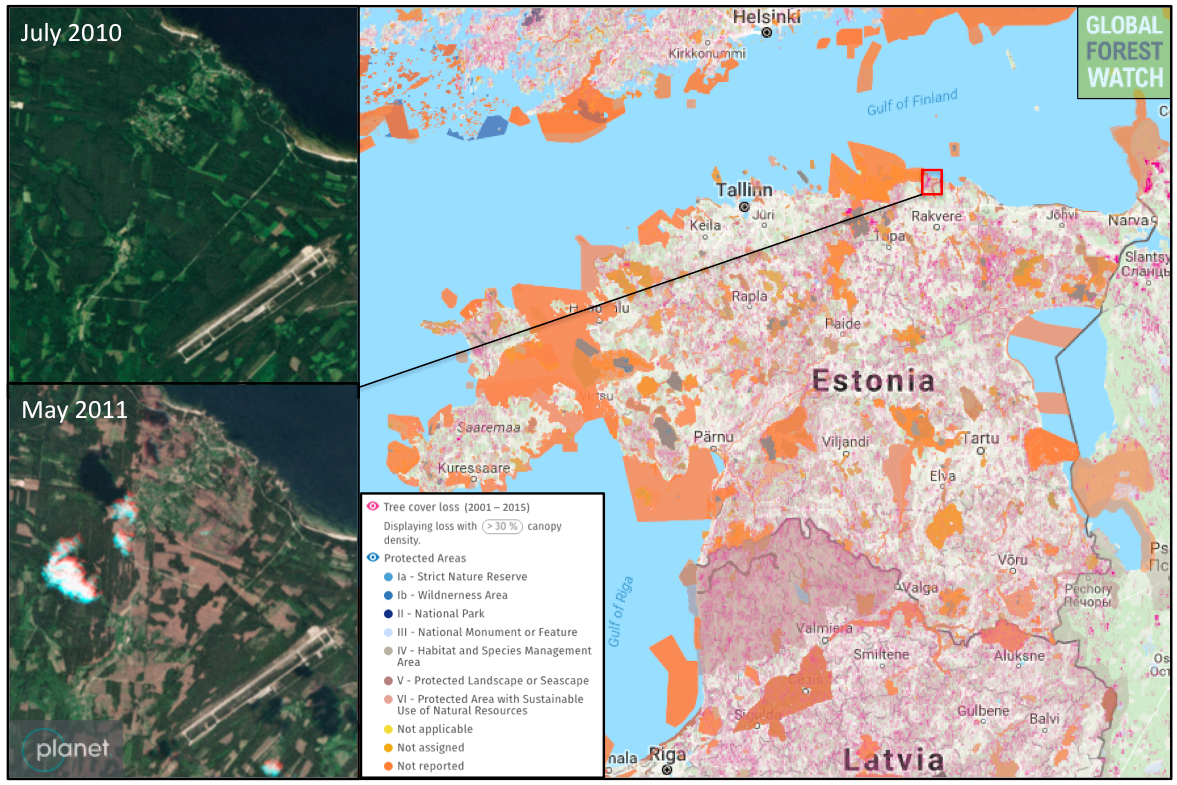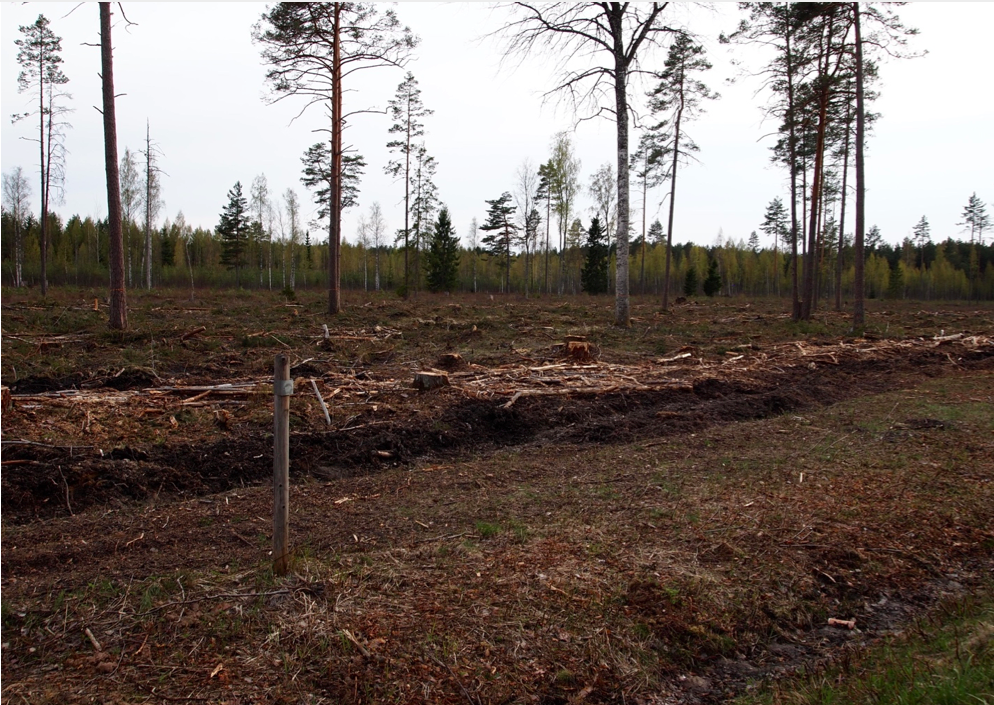- Soviet rule in the early 20th century led to the regrowth of many of the country’s forests. Today, Estonia is Europe’s fourth-most forested country.
- As private land ownership and industry expand in the country, however, so are the pressures to log.
- Estonia’s Ministry of Environment claims that Estonia’s forests are currently expanding in size, but conservation scientists say the opposite is true. Satellite data indicate the country gained 90,000 hectares of tree cover while losing 285,000.
- Local conservation organizations are pressing the government to adopt more sustainable practices, including a ban on logging during part of the year and the cessation of a new logging amendment that would lower the felling age of spruce trees.
When the last of the Russian troops pulled out of Estonia in 1994, for many their departure was bittersweet. While most Estonians were eager to join the Western world and reestablish cultural ties with Finland and other Nordic countries, the country’s transition from communism to capitalism was hindered by poverty, cultural barriers, and dilapidated infrastructure. Today, however, Estonia appears to be coming into its own. The country has joined the EU, ranks 30th in the world on the Human Development Index, and has one of the fastest-growing economies in Europe.
Estonia now has the autonomy to decide how it is going to allocate its resources, and how it wants to shape its identity on the international stage. Central to this decision is one notable parting gift left by the country’s Soviet occupiers: trees.

Trees are “one of the few positive things inherited from the age of Soviet domination,” said Linda-Mari Väli, founder of Helping Estonia’s Forests, a conservation-oriented citizens’ initiative. While Estonia is historically a tree-dense country, by the early 20th century much of its forestland had been converted to farms. Under Soviet rule, however, private landownership, and private farms, were abandoned for large collectives. By the time Estonia gained independence, the forest had reclaimed much of its former territory.
The country now has over 50 percent tree cover, according to satellite data from the University of Maryland analyzed through Global Forest Watch. Of its forests, assessments by the UN’s Food and Agriculture Organization (FAO) pegs 90 percent as “naturally regenerated” and 3 percent old-growth. It is the fourth most forested country in Europe, and ranks eighth on the 2016 Environmental Performance Index.

As private land ownership and industry expand in the country, however, so do the pressures to log. Estonia’s choices now appear poised affect the future of the country’s forests. Can a country that reforested largely through neglect now use this accidental opportunity to build a purposeful, forward-looking sustainable forest management model? Or will it follow in the footsteps of other post-Soviet countries currently systematically destroying their forests for short-term economic gain?
Mongabay spoke to local scientists and representatives from local organizations and government agencies, finding a country still battling some communist cultural hangovers but eager to look forward and embrace the concept of sustainability. While everyone with an interest in Estonia’s forests appears to embrace the word, opinions differ as to what it means, and what goals Estonia should ultimately be striving for.
Environmental activism has played an important role in Estonia’s political history. The Estonian Green Movement, established in 1988 to protest Soviet phosphorite mining, was one of the strongest opposition forces against the country’s occupiers. Its ultimate, highly ambitious goal went far beyond that single environmental issue – the Movement called for independence from the Soviet Union and establishment of the Green Republic of Estonia, a non-hierarchal country that promoted environmentally sound technology and lifestyles, preservation of wild places, and reasonable resource usage.
This vision was lost once Estonia did gain independence, as the country struggled through the hardship of reintegrating with the Western world. Protest of any kind, in fact, disappeared during the 90s and early 2000s. In a 2002 survey, over half of Estonians said they would not take part in a collective protest, and over 40 percent said they had no interest in volunteering. Fear of the government—a holdover from the communist era—lingered, and advocacy waned.
Last year, Linda-Mari Väli founded Helping Estonia’s Forests. Since then, the little initiative has made a name for itself as one of the more successful activist group since the country’s independence. Helping Estonia’s Forests hopes to bring the idea of a country built on sustainable values back into the public consciousness.
Although a young initiative in a country where any form of public protest is unusual, its efforts have been met with growing support. While one protest—against a military building expanding its border into a future conservation area—was carried out by a grand total of four people, there are signs that the idea of public protest is gaining momentum. In the middle of a harsh Estonian winter last December, hundreds turned out with Helping Estonia’s Forests to protest a logging amendment that would lower the felling age of spruce trees.
Martin Luiga, a member of Helping Estonia’s Forests, said that their success is built on reclaiming the idea of public protest. “The whole concept of civil disobedience is rather new to Estonia,” he said in an email. Protest, and picketing, is still considered a “Western-style tactic.”
Thus far, the movement’s primary achievement has been momentum, but some concrete actions have come out of its protests. They helped pressure the government to sign a flying squirrel defense program, and won full protection for an additional 1 percent of state forests. Their primary objective now is a decline in national deforestation rates and the establishment of green corridors to link protected areas. According to founder Väli, the ultimate goal of the initiative is to achieve representation for uses of the country’s forests in addition to logging (such as tourism, berry-picking, and wildlife conservation) “without discrimination.”


Asko Lõhmus, lead research fellow of conservation biology at the University of Tartu, explained that Estonia is in many ways managing its forests better than other nearby countries. According to Lõhmus, Estonia allows more natural regeneration after clear cutting, leaves more dead wood, and has a good network of protected forest. However, he said that because of the chance it was given upon gaining independence, the country has—or had—the opportunity to do much more.
“I think there was an excellent opportunity in the 1990s for Estonia to become a global innovator of sustainable forest management. Despite many people having worked toward it, I am afraid we are losing this hope now … recent trends are drifting us away from the sustainable and multi-purpose forestry course,” Lõhmus said.
Satellite data from the University of Maryland backs up this statement: Estonia lost more trees in 2015 than it had in the previous 15 years, with the exception of 2011. In total, the country lost around 285,000 hectares of tree cover cover between 2001 and 2015 while gaining 90,000 hectares.
Estonia’s Ministry of Environment and Private Landowner’s Association, however, both appear to think that current forest policy is fully in line with the idea of sustainable management.
“The main objective of our National Forest Programme 2020 is to ensure the viability and productivity as well as diverse and efficient use of forests,” said Marku Lamp, Deputy Secretary General for Wildlife in Estonia’s Ministry of Environment. He described current forest usage as “well balanced,” with 12 percent of Estonia’s forests under strict protection and about 75 percent managed for commercial purposes. Lamp and Lõhmus both cited retention trees (mature trees required by law to be left in clear-cut areas to facilitate healthy re-growth) as an example of a good management practice in Estonia.
However, while the Ministry of Environment claims that Estonia’s forests are currently expanding in size, Lõhmus said his research indicates that Estonia is losing forest—a conclusion more in line with Global Forest Watch satellite data.

Trees are an integral part of the country’s economic and cultural exchange with its northern neighbors. Both Luiga and Lõhmus believe that Estonia would benefit from better, more transparent data on the state of its forests.
“The competitiveness of the timber industry is extremely important for the Estonian economy,” Lamp said. He then, however, went on to highlight how Estonia abides by the “Nordic principle of free access to nature,” allowing berry-picking and the gathering of mushrooms and medicinal plants. Access to, and exploitation of, Estonia’s forests are both part of its modern ethos, but one requires the careful monitoring of the other. But only half of Estonia’s forests are under government control; the other half are privately owned.
To this end, Mikk Link, the chairman of the board for the Estonian Private Forest Union, said that his organization’s primary objective is “to ensure our members [a] good environment for sustainable forest management.” Link cited “not exceeding the annual growth of the forests with the logging” and “avoiding forestland being transformed to other types of land use” as criteria for good sustainable management.
Luiga from Helping Estonia’s Forests also noted that the Estonian Private Forest Union recently pressured the government not to pass a seasonal ban on logging, designed to protect nesting birds. While scientists, activists, private landowners, and the government all use similar language to describe their goals, the actions of the latter two indicate short-term monetary gain ultimately takes priority—at least right now.
The fate of Estonia’s forests, then, appears to rest on its willingness to taking the long view. But for a newly capitalist country, the short-term benefits of intensive logging could prove too alluring to resist.
“For almost a year, there has been an unprecedented societal discussion on the state and future of forests in Estonia,” Lõhmus said. “It is unclear how that will end.”
Citations:
- Raudsepp, Maaris, Mati Heidmets, and Juri Kruusvall. “Environmental justice and sustainability in post-Soviet Estonia.” Environmental Justice and Sustainability in the Former Soviet Union. MIT Press: Cambridge, Massachusetts (2009): 215-237.
- Rausing, Sigrid. Everything is Wonderful: Memories of a Collective Farm in Estonia. Grove Press: New York, New York (2014).
FEEDBACK: Use this form to send a message to the editor of this post. If you want to post a public comment, you can do that at the bottom of the page.
